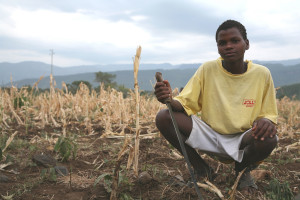Drought in Africa has been a destructive force to life and property since the beginning of recorded time. Most recently, East Africa suffered a severe drought in 2010 that persisted nearly the entire year. However, one good thing that came out of this catastrophic drought was that it revealed several important hints for predicting future long-term droughts.

Agriculture suffers when either the long rains or the short rains fail to materialize in a given year, but especially when they both fail to materialize. Image reproduced from USAID.gov.
East Africa has two annual cycles of rainfall that it depends on for drinking water and agriculture: the ‘short rains’, which typically last from October through December, and the ‘long rains’, which last from March through May. Both were concurrently absent during the 2010 drought.
Climate scientists had previously found a strong connection between El Niño/La Niña and the short rains in East Africa, and 2010’s short rains were successfully predicted to be significantly lower than usual. Forecasting the lack of long rains, however, continued to baffle scientists until a team from Columbia University noticed a possible correlation with abnormally warm sea surface temperatures in the western and central Pacific Ocean during 2010.
When such a correlation is hypothesized, it is important that climate scientists examine past data to see if the trend matches up in similar scenarios. In this case, when the Columbia scientists’ hypothesis was tested against eight previous cases of abnormally warm waters in the western Pacific, seven of the eight most recent long rain droughts in East Africa could be accurately predicted and explained.
This is an outstanding discovery, but could still benefit from the analysis of more cases from further back in the past.
As it stands, climate scientists believe that they now have a slightly better understanding of how to forecast the short and long rains in East Africa. They also have a general idea of the trend of global water availability under a warming climate – for East Africa, USGS models are predicting a ten to forty percent increase in precipitation by 2050.

Various data rescue projects by IEDRO.
It is uncertain which effect will dominate over time, warmer sea surface temperatures in the Pacific (East Africa drought) or this USGS predicted increase in precipitation by 2050.
Data rescue will continue to be a key link in this quest for understanding. As the saying goes, hindsight is always twenty-twenty, and the more accurately we can understand what has happened before, the more accurately we can predict (and be prepared for) what will happen in the future. The only way we can achieve this prior knowledge is by digitizing and utilizing historical records, gravid with data, just waiting to be amassed and understood as a whole.
References
Milly, Christopher. “Climate models help scientists understand global shifts in water availability.” USGS Newsroom. 16 November 2005. USGS. 23 Mar. 2012.
Nakweya, Gilbert. “Study links African drought to Pacific sea temperature.” Agriculture & Environment: Natural Disasters. 16 Mar. 2012. SciDev. 23 Mar. 2012.

Comments are closed.